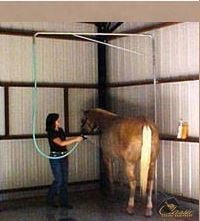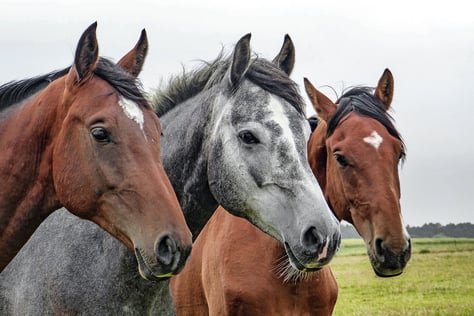 An indoor wash bay is a necessity for any well-planned barn. They are typically the same size as a stall. They can be used for many other tasks as well – grooming, tacking up, shoeing and vet visits.
An indoor wash bay is a necessity for any well-planned barn. They are typically the same size as a stall. They can be used for many other tasks as well – grooming, tacking up, shoeing and vet visits.
One of the main things you’ll need for your wash bay is access to water. While cold water is often sufficient, installing a tankless water heater for instant hot water will make your barn a big favorite with anyone who boards there. There is nothing that says that a wash bay must be inside the barn. In fact, in places with mild winters, most bathing is done in outside wash racks. But whether you are indoors or outdoors, there are still some things you must consider. If you are the handy do-it-yourselfer, much of the construction and plumbing can be done by you. But it’s best to have a building contractor look at your plans first - once you get started, it’s much more difficult to correct any mistakes.
When creating the overall design for your barn, think ahead of time where you want to put your wash bays. Since a quick rinse is often done on hot summer days after riding, the bay might be positioned near the tack room. Or to help it dry out more quickly, you may want to put the bay at either ends of the stable. One place NOT to put a wash bay is somewhere that is either too high traffic or too isolated. When bathing your horse, you are basically tying him into a 12 x 12 dark, wet area and that can be intimidating for some areas. Good lighting, which we’ll discuss later, is very important.
Once you’ve identified the space, now it’s time to make it as water resistant as possible. Using metal or water resistant wood or wood-like paneling will help keep the area dry between baths. Other options are concrete blocks painted with a waterproof sealant or some sort of fiberglass panel.
A non-slip floor with a drain is an absolute necessity. If you are making a wash rack outdoors, this can easily be done by putting several layers of crushed gravel down and allow the water to simply seep down through the layers and away. However, for an indoor wash bay, there are more options. While mats and concrete are the two most often used, both have their down sides. Concrete is hard on a horse’s legs and can become slippery when wet. Scoring the concrete with grooves will make it less slippery and direct the water more easily to the drain. Stall mats in wash bays should be removed periodically and both the mats and the floor underneath be allowed to dry after cleaning with a disinfectant to eliminate mold or mildew and remove any mud or manure that may have collected there. Another option is to use rubber pavers in the wash bay
When putting in the flooring, make sure that the bay slopes to help keep your horse from standing in water. A general rule of thumb is one inch of slope for every six feet of stall. There are several places to install your drain. One of the most common is right in the middle of the wash bay. But some horses can be spooky and not want to step on that “thing” in the middle of the floor. Be sure you add a removable trap for cleaning. Another option is to put the drains near the back of the bay and use a removable grate.
Lights and radiant-heaters are great additions to your wash bay. Infrared heaters can be added to help take the chill off a wet horse in cool conditions. While heaters work best when installed directly over where the horse will be standing, lights should be installed on either side of the stall ceiling or on the side walls to prevent shadows that could spook a horse. Add shelves or cabinets for common grooming supplies like brushes and shampoo and/or medical supplies. Look for cabinets made of plastic or metal – wood or laminate can fall apart too easily.
Hoses are a necessary part of any bath, but are often the most aggravating part of the process. Some people coil them up after use; others leave them strewn around so your horse has to step over them to get into the bay. The best solution is an “over-the-top washer.” The wash unit keeps the hose above the animal’s head and off the floor, making it easy to move quietly and quickly through the bathing process.
Check out our web site for more wash bay ideas and accessories.



